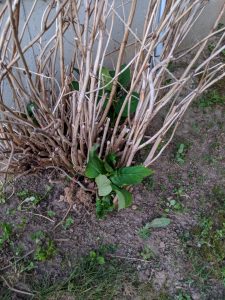To know if a hydrangea is dead, observe the appearance of the leaves and stems, and check if there is any sign of new growth. If the hydrangea has wilted or dried leaves, brittle stems, and no new shoots, it may be dead.
Hydrangeas, with their vibrant blooms and lush foliage, are a popular choice for gardeners and homeowners alike. These beautiful flowering plants can add a touch of elegance and charm to any landscape. However, like all living organisms, hydrangeas can become sick or even die.
If you own a hydrangea and are concerned about its health, it is important to know how to determine if it is dead or simply in need of some extra care. We will discuss the signs that indicate a hydrangea may be dead, as well as provide some tips on how to revive a struggling plant. By understanding these indicators, you can take the necessary steps to ensure the longevity and beauty of your hydrangea.

Credit: www.reddit.com
How to Know If Hydrangea is Dead: Step by Step Guide
Brown And Wilted Leaves
When it comes to hydrangeas, it can be concerning to see brown and wilted leaves. This may indicate that the plant is not in the best condition. One possible sign of a dying hydrangea is leaves turning brown and wilting. These brown and wilted leaves may also have a dry and crispy texture. Additionally, if the leaves lack green coloration, it could be a sign of the plant’s health deteriorating.
To determine if your hydrangea is dead, it’s important to assess the overall condition of the plant. Check for any signs of life such as new growth or healthy stems. If the entire plant appears lifeless and shows no signs of recovery, it may be time to consider the possibility that your hydrangea has passed away.
Absence Of New Growth
No signs of regrowth after winter can be a clear indication that your hydrangea might be dead. Lack of new shoots and buds is another sign to watch out for. If you notice stunted or withered branches, it’s likely that the plant is not thriving. In such cases, it’s important to assess the overall health of the hydrangea. Check for other symptoms such as discoloration or brittleness in the stems.
Pay attention to the soil moisture and drainage as well, as improper conditions can contribute to the plant’s decline. Remember to prune any dead or damaged stems to promote new growth. If you suspect that your hydrangea is dead, it’s best to consult with a horticulturist or arborist for a professional assessment and guidance.
Weak Or Lifeless Stems
One way to determine if a hydrangea plant is dead is by examining its stems. If the stems are brittle and easily break, it could be a sign that the plant is no longer alive. Additionally, if there is no flexibility in the stems and they feel rigid or stiff to the touch, it indicates that the plant may be dead. Another indication is the lack of moisture and plumpness in the stems. If the stems feel dry and shriveled instead of being firm and full of moisture, it suggests that the plant has died.
Examination Of Hydrangea Roots
Inspecting the root system of a hydrangea is an essential step in determining if the plant is dead or not. Look for any discolored or blackened roots, as this may indicate rot or disease. Healthy roots should be firm, white, and show signs of life. On the other hand, empty and lifeless roots are a clear indication that the hydrangea is dead. These roots may appear dry and brittle, lacking any signs of vitality.
It’s important to carefully examine the entire root system, as even a few dead or damaged roots can impact the overall health of the plant. If the majority of the roots are discolored, empty, or lifeless, it’s likely that the hydrangea has reached the end of its lifespan.
Lack Of Blooms Or Flowers
When it comes to determining whether a hydrangea plant is dead, one of the key signs to look out for is a lack of blooms or flowers. If during the blooming season you notice an absence of new blooms, it could be an indication that the hydrangea is not thriving. Another telltale sign is the absence of vibrant colors or pigmentation in the flowers. Healthy hydrangeas typically display vibrant hues, so if the blooms appear dull or lack their usual pigmentation, it may be a sign of a dying plant.
Additionally, keep an eye out for dead or shriveled flower buds. If the buds fail to open or appear withered, it suggests that the plant is not receiving adequate nutrition or moisture. These factors combined can help you determine the health of your hydrangea and take appropriate action if needed.
Professional Opinion And Assistance
Seeking guidance from a horticulturist or gardener can provide invaluable insight into determining whether your hydrangea is dead or not. These experts are knowledgeable about plant health and can assess the signs that indicate the plant’s condition. Consulting local nurseries or garden centers is also beneficial, as the professionals there may have specific experience with hydrangeas or can refer you to someone who does. Additionally, getting a second opinion from experts ensures a thorough evaluation of the plant’s viability. By reaching out to professionals, you can gain clarity and make informed decisions regarding the health of your hydrangea.
Revival Methods And Care Tips
Reviving a hydrangea plant requires implementing proper watering and soil conditions. It is crucial to water the plant regularly, ensuring that the soil is consistently moist but not waterlogged. Hydrangeas also thrive in well-draining soil, so adding organic matter such as compost can improve water retention while preventing excessive moisture.
Another important factor is providing sufficient sunlight and shade. Hydrangeas need at least 4-6 hours of direct sunlight to grow well, but they also benefit from some shade during the hottest part of the day, especially in hotter climates.
Pruning and removing dead parts of the plant is essential to promote growth and prevent disease. Regular pruning in early spring helps remove dead or damaged branches and encourages new growth.
| Revival Methods and Care Tips: |
|---|
| – Water the plant regularly |
| – Ensure well-draining soil |
| – Provide 4-6 hours of direct sunlight |
| – Offer some shade during the hottest part of the day |
| – Prune dead branches in early spring |
Frequently Asked Questions Of How To Know If Hydrangea Is Dead
How Do You Revive A Dead Hydrangea Plant?
To revive a dead hydrangea plant, prune all dead and damaged branches, provide adequate water and sunlight, and ensure proper fertilization.
What Does A Dying Hydrangea Look Like?
A dying hydrangea appears wilted, with droopy leaves, discoloration, and lack of new growth.
Can You Revive A Dead Hydrangea Bush?
Yes, it is possible to revive a dead hydrangea bush with proper care and attention.
What Do Dead Hydrangea Stems Look Like?
Dead hydrangea stems are brown, brittle, and devoid of any signs of growth or vitality.
Conclusion
Determining whether a hydrangea is dead or alive can be a crucial task for any gardener. By closely observing the plant’s physical appearance and following some helpful tips, you can make an accurate assessment. Take note of the color of the leaves, as a brown or grayish hue may indicate the hydrangea’s demise.
Additionally, inspect the stems for any signs of new growth, such as buds or green shoots. If the plant is showing no signs of life, it may be time to accept that it has perished. However, before giving up completely, it’s worth undertaking some efforts to revive it.
From providing proper watering and sunlight to pruning and fertilizing, there are various steps you can take to potentially bring a seemingly lifeless hydrangea back to its former glory. Remember, early intervention is key, so don’t hesitate to act promptly when signs of distress become apparent.
With care and perseverance, you can ensure the survival of your hydrangea and continue enjoying its beauty in your garden.

